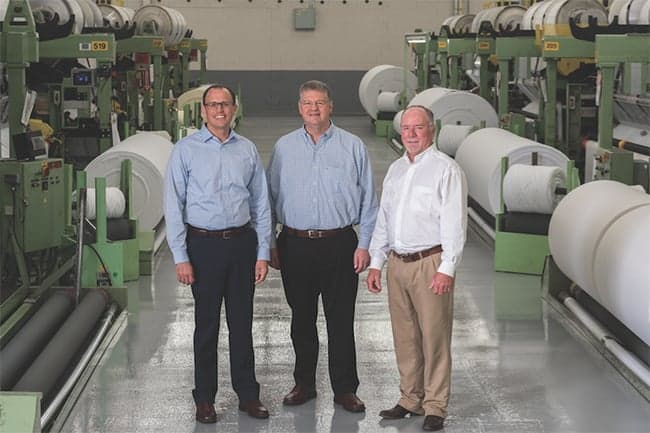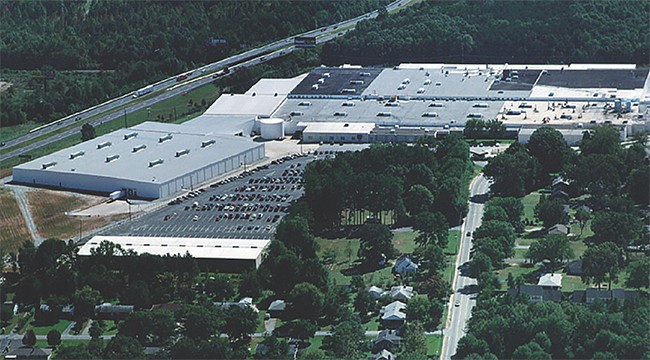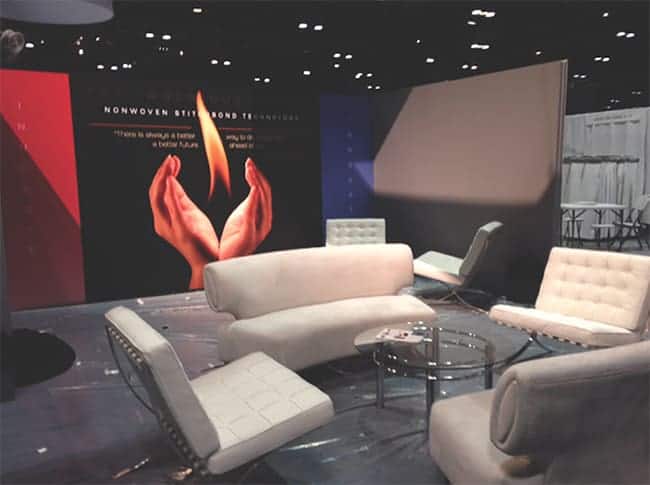BY GARY JAMES
The supplier has grown its business with solution-oriented products from anti-skid to FR

Tietex International Ltd.’s executive team checks in on the company’s stitchbonding operation in Spartanburg, South Carolina. The team includes (from left) Wade Wallace, president and chief operating officer; Martin Wildeman, chair and chief executive officer; and Rhett Lancaster, vice president of sales and marketing.
Tietex International Ltd.’s core product line for the bedding industry—stitchbonded filler fabrics—may appear to be a narrowly defined niche. But in an industry where the variety of bed constructions has grown exponentially, so too has the Tietex line. Today, the company’s ever-evolving product assortment features highly technical and engineered fabrics, each with specific features tailored to meet the needs of individual mattress manufacturers and, in many cases, individual bed models.
“In the 40 years since our founding, Tietex has developed and refined stitchbond technology, acquiring numerous patents, to become the world’s largest stitchbond nonwoven supplier,” says Wade Wallace, president and chief operating officer. “In recent years, our global footprint has steadily expanded as we have approached new markets with ideas that extend our influence around the world.”
Deep roots
Arno Wildeman founded Tietex in Spartanburg, South Carolina, in 1974. Wildeman had emigrated to the United States from the United Kingdom two years earlier to establish a U.S. presence for Cosmopolitan Textiles Ltd., a British company he co-founded in 1968 with Cha Chi Ming, a Chinese investment partner. Cosmopolitan was an early pioneer in the commercialization of stitchbonding, a fabric formation invented by Heinrich Mauersberger in 1949 that increases the versatility of nonwoven substrates, films, papers and foams by introducing yarn into the production process.
In the early 1970s, Wildeman re-engineered the original Mauersberger concept to incorporate new capabilities and that new technology platform became the foundation of unique process capabilities that Tietex continues to build on to this day.
Also in the early 1970s, Tietex introduced the world’s first filler cloth for bedding. Today, virtually all U.S. bed manufacturers put filler cloth on the bottom of mattresses, on bed foundations or on both components. This construction minimizes production time and expense, while also creating one-sided, no-flip mattresses with the anti-skid properties on the nonsleep surface that they need to stay in place.
In its early years, Tietex primarily was a greige mill that produced white fabric to sell to converters, who in turn used the material to make fabric for the mattress trade. In the early 1980s, the company began selling directly to mattress manufacturers. Today, it is the only domestic producer of stitchbonded fabric focused on the bedding market.
Arno Wildeman had purchased his partner’s interest in Tietex soon after the company’s launch and when he died in 1987, Tietex’s ownership transferred to his son, Martin Wildeman, who now serves as chair and chief executive officer. Like his father, Martin Wildeman remains deeply committed to maintaining the company’s reputation as a world-class global manufacturer and innovator of proprietary textile products and processes.
Tietex’s headquarters facility is in Spartanburg, where it has 770,000 square feet of manufacturing space and a 250,000-square-foot distribution center, along with offices. About 300 people work at that site, which serves the North American and Central American markets.
In addition, Tietex has a 350,000-square-foot manufacturing facility in the Chonburi province of Thailand. That plant opened in 1997 and focuses primarily on serving the growing Asian market. The company also has a sales and marketing office in the Netherlands. Tietex employs more than 600 people worldwide.
“Both our production facilities have the same capabilities and, in some cases, we have exported products between the two locations to meet an increase in demand,” Wallace says. He noted that the Thai facility does a lot of business with the footwear and automotive industries, in addition to its mattress industry activity.
Globally, mattress fabrics account for about half of Tietex’s annual sales. While the bedding industry remains the No. 1 business sector for Tietex, the company also is seeing steady growth in a range of other industries. Other key product segments include cleaning and disinfection materials, roofing fabrics, shoe insoles, hook and loop fasteners for the diaper and hygiene markets, and noise-dampening and seating reinforcement applications for the auto industry.

Tietex’s 1 million-square-foot-plus facility in Spartanburg is one of two production facilities. The other is in the Chonburi province of Thailand.
A pioneer in FR fillers
In the home furnishings space, Tietex specializes in mattress filler cloth. At one time, the company also offered decorative print ticking but, in 2008, it began phasing that line out to concentrate more resources toward the development of cutting-edge FR and other technical products.
“When new federal open-flame mattress standards took effect in 2007, the sleep industry was turned upside down and we were under a lot of pressure to help U.S. bedding manufacturers come up with solutions,” Wallace recalls. “We had to step up and be a leader in this space because our customers were counting on us. We put our entire company behind the effort.”
Developing a comprehensive lineup of cost-effective FR products positioned Tietex as a top supplier of filler fabrics to the mattress industry. Now, 10 years later, the company continues to be a world leader in this segment.
At the International Sleep Products Association’s EXPO in March 2016, Tietex introduced its third generation of FR filler cloth for the bedding industry, featuring a new, patented FR rayon with silica.
This updated line “delivers enhanced FR performance, with a dramatic increase in char strength and a substantial increase in time to failure,” Wallace says. “Our unique coating process along with our internal stitchbonding capabilities are what distinguish our FR fillers from others in the market.”
Rhett Lancaster, vice president of sales and marketing, says the new filler is “an ideal FR solution” because it offers four performance grades for virtually any mattress style and price point. “We have designed these products to be lightweight, yet durable,” Lancaster says. “The overall performance characteristics are preferred by major brands that serve both the consumer and hospitality markets.”
With each generation of its FR fillers, Tietex has worked to increase performance while reducing costs. “We’re always looking for which combination of materials gives the best overall cost and performance,” Wallace says. “Instead of putting the cheapest materials we can think of into the product, we use proprietary mixes of higher priced raw materials that reduce costs because they are much more effective.”
Tietex works closely with customers to keep costs manageable, Wallace adds. “For example, we might point out to a manufacturer how spending more on one element of a product might save on two other things and result in a net cost improvement,” he says.
Tailored solutions
Founded by an entrepreneur with a relentless spirit of innovation, Tietex continues to look for new and better ways to do business. “In mattresses, we’re focused on performance and protection,” Wallace says. “Fire retardancy is a huge part of what we do, but we also see a lot of opportunity in non-FR materials.”
Today’s mattresses feature more complex and heavier constructions with different requirements in terms of weight management, handle placements and adjustability, he says. That calls for new types of filler fabrics with various levels of strength, elongation and other tensile properties. Within the FR arena, bed producers also have a wide range of needs. For instance, some producers want more char strength, while others want more flame-extinguishing characteristics.
In pursuing its ongoing research-and-development mission, Tietex has a dedicated team at its Spartanburg facility, along with an accredited testing lab. But the company’s R&D activities aren’t confined to a single department or workspace. “R&D is very integrated at Tietex. It’s a core activity that extends across the entire enterprise,” Wallace says. “Everyone—from our owner, the world’s expert on stitchbonding technology, to our senior managers and line workers—is constantly looking for ways to improve and innovate our products and processes.”
While much of Tietex’s R&D is focused on responding to emerging market needs, the company also stays on the lookout for new advances in fibers, polymers and other raw materials that might have an application for bedding. “We approach R&D from two directions: what the market is looking for, but also what new materials and approaches are emerging that could be integrated into our processes,” Wallace says.
The fact that Tietex is involved in so many industries gives it a natural vantage point from which to spot new opportunities. “We’re all over the world in lots of different spaces,” Wallace adds. “Our view isn’t confined to one business, so we get ideas from many places that we can draw on and adapt.”
In addition to its work on the FR front, Tietex has been busy developing new anti-skid fillers and decking. The company has long been a pioneer in this area through its Clings line, but, with the surge in the number of adjustable beds being sold, demand is rising for filler cloths with varying anti-skid and slippage properties.
“We have a lot of experience and capability in the coefficients of friction—the amount a product will or will not ‘fly’,” Wallace says. “And producers want both features, depending on the type of product they are making. For an adjustable base, they may want the mattress to slide a little more. But on a nonadjustable, they want it to slide less. It goes both ways.”
Also creating new opportunities for Tietex is the boxed-bed trend, and the company has developed a variety of new products to service that segment of the market. “We’ve been watching this business grow for many years and have developed a number of filler solutions for these producers,” Wallace says. “Because these mattresses are compressed and rolled, filler fabrics need to have particular properties to hold up under those strains.”
Another area where Tietex’s R&D efforts are particularly active relates to anti-microbial filler fabrics. “In the past few years, we’ve done a tremendous amount of work in this area,” Wallace says. “Demand for anti-microbial properties for bedding is growing rapidly in all sectors of the business—residential and medical and hotel applications.”
Temperature and moisture control are additional areas for ongoing R&D initiatives.

The Tietex booth at the International Sleep Products Association’s EXPO in March 2016 evoked the company’s broad capabilities and product lineup, including FR solutions for bedding makers.
The vertical advantage
Except for the sourcing of fibers and yarns, Tietex makes all of its filler fabric lines nearly from scratch. Its capabilities include fabric formation, printing, dyeing, finishing and converting. This vertical capability gives the producer an advantage when it comes to developing custom products.
“We can do very rapid R&D work when required,” Lancaster says, adding that being vertical also enhances the level of service that Tietex delivers. “For our stock programs, we can deliver products the next day or, in many cases, the same day. Special orders go out within two to three weeks.”
Going forward, Tietex expects to continue to raise the bar in the level of service and innovation it provides to manufacturers. “We have to keep evolving,” Wallace says. “As the only domestic manufacturer and supplier, our cost structure is not always the lowest, so it’s critical that we offer the best service and innovation.”
Lancaster adds, “We have to stay on our toes to make sure we continue to evolve our products to meet the needs of a fast-changing industry.” Along with its unwavering commitment to new product development, Tietex also will be looking for new ways to improve its production efficiencies, with automation playing a big role.
“We have a significant five-year plan around modernization and automation, and we’re about one year into it,” Wallace says.




